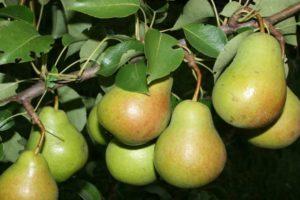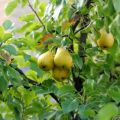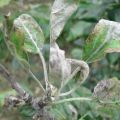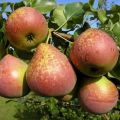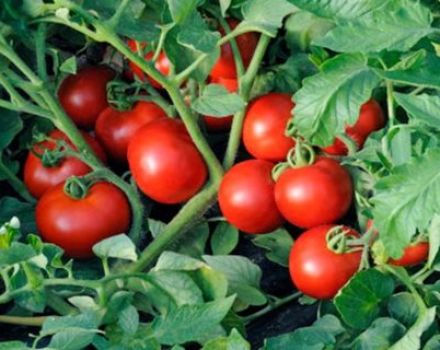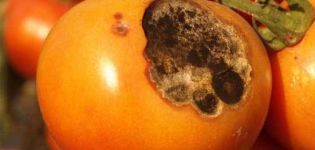Description of summer, autumn and winter pears, which ones are better to choose
Among horticultural crops, the pear is the second most popular after the apple tree. The cultivation of the plant took place after the selection of the wild pear growing in the forests of the European part, Central Asia, and the Caucasus was successful. Now for gardeners they offer a large selection of pear varieties, both summer, autumn and winter types.
Content
- 1 Summer pear varieties
- 2 Autumn
- 3 Winter
- 4 Pears of central Russia
- 5 Other types
- 6 Varieties for the Moscow region
- 7 Other varieties
- 8 Varieties for the Southern Federal District
- 9 Disease Resistant Pear Varieties
- 10 Self-fertile pear varieties
- 11 What kind of seedlings is better to choose
- 12 How to identify a pear variety
Summer pear varieties
Pears ripening in summer have a number of advantages over other types of fruit crops. They are self-fertile, although there are varieties that require pollination. Most of all, the summer culture of those varieties that give early harvests and begin to bear fruit in the 5th year of the tree's life. Therefore, they are called early.
The varieties differ:
- prevalence in a particular region, from southern to northern regions;
- various forms of fruits;
- their keeping quality;
- sweet or sour taste of fruits, their astringency;
- tree growth, crown shape.
For the best choice of tree for the garden, it is more convenient to study the varieties alphabetically.
August dew
As a result of crossing Tenderness with Pakgam's Triumph, the pear turned out to be:
- smooth gray bark;
- spreading branches, slightly drooping, curved;
- fruits are sweet, covered with a delicate and thin skin.
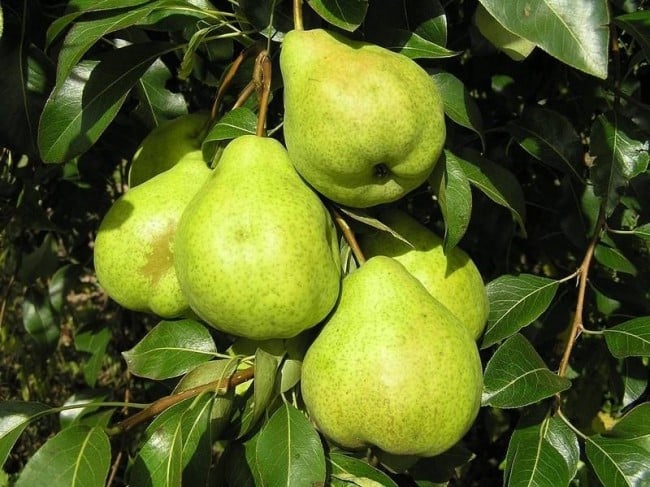
The plant reaches a height of 10 meters in adulthood. The culture is appreciated for the fact that it rarely gets sick, easily tolerates winter cold, and blooms quickly in spring.
Bashkir summer
The tree begins to bear fruit in the 6th year of life, and in July fruits already appear on the branches. The tart, fine-grained pulp is slightly loose, but does not deteriorate for a long time. The tree has a pyramidal crown, so it can become a decoration of the site. The variety is suitable for growing not only in southern regions, but also in temperate climates.
A positive characteristic is that the plant is resistant to major diseases, yields annual yields of up to 16 kilograms.
Whiteleaf
A pear with consistently good yields has many benefits.These include both frost resistance and average disease resistance. Fruits with a yellowish skin and juicy, dense pulp reach technical ripeness in the last month of summer. The only drawback is that pears cannot be stored for a long time. They begin to deteriorate after 10 days.

Bere Giffard
For the southern regions, a variety with wonderful reddish fruits, which hang in bunches of 2-5 pieces each, is especially suitable. The brightness of pears is combined with the tenderness and juiciness of the pulp, hidden under the thin skin. The fruits can not be picked immediately, they hang for a long time and do not deteriorate on the branches. Shoots often have to be tied up so that they do not break under the weight of a rich harvest.
Everything is beautiful in the plant: a rare crown with curved thin branches, and a smooth trunk 10 meters high, and oblong green leaves.
Victoria
Yielding varieties are represented by Victoria pear. And not without reason, because up to 150 kilograms of fruits are harvested from an adult tree. They are suitable for making jams, preserves, compotes. After harvesting in August-September, it is better to immediately process sweet and juicy pears, because they cannot be stored for a long time. They will start to deteriorate after 3 days, and on the tree after a week.
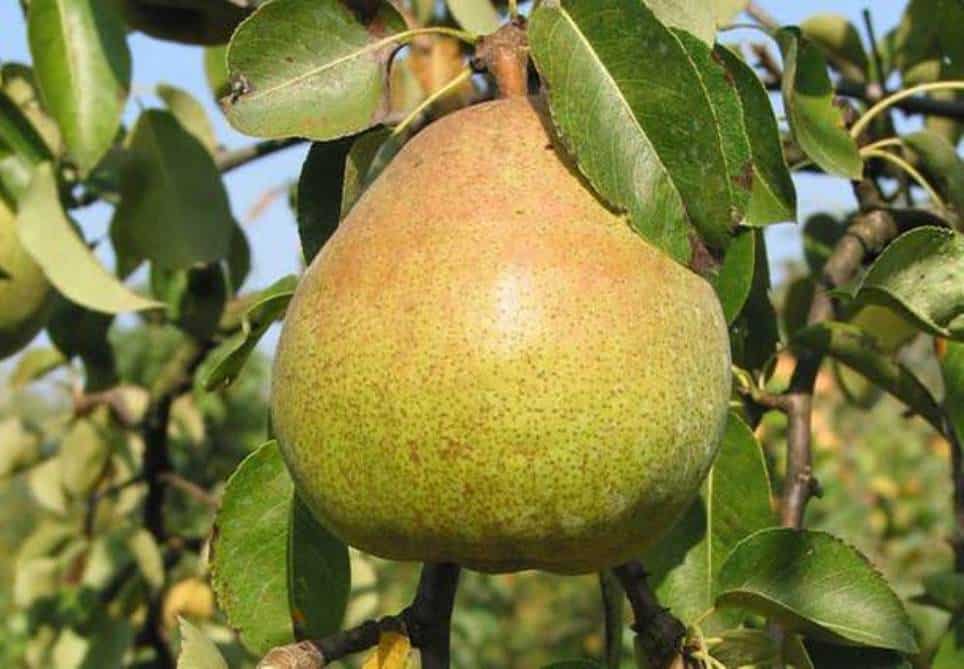
Duchess
One of the popular pears. Its fruits are recognizable as they are sweet and tender, juicy, with a thin skin. Greenish-yellow, they reach a weight of 150 grams. And they are stored for a long time, and hang on ripe branches without falling off or spoiling. English selection tree suitable for small gardens. It has a compact crown, consisting of spreading thin branches. The plant can tolerate frost. And also not exposed to pathogenic fungi. Of the pests, aphids are the most dangerous.
Carmen
This pear variety is widespread in central Russia. With a tree height of 5-6 meters, a pyramidal-narrow crown, the plant has interesting reddish leaves, their curved plate, neatly folded. The short pear-shaped fruit is of medium size. As it matures, the skin turns red and then turns brown. A large number of inclusions are visible on it. The white semi-oily pulp is juicy and tasty with a predominance of sugar and a low acid content.
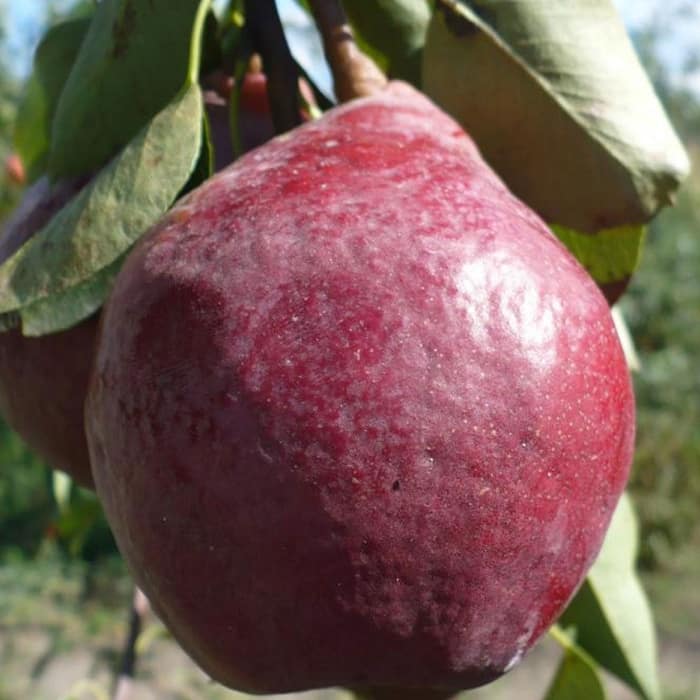
Cathedral
The variety was bred by the scientists of the Timiryazev Academy by crossing the Forest Beauty with Duchess. In a medium-sized tree, the branches are directed upward. On reddish-brown shoots, the leaves are light green with pointed tips.
The mass of pear fruits is small, within 100-120 grams. They are of a classic shape with a bumpy surface. White flesh is hidden under the delicate, slightly oily skin. The color of the fruit is from greenish to light yellow with a blush spread over the surface. The taste of pears is estimated at 4 points. They ripen in August and are stored for 10 to 12 days.
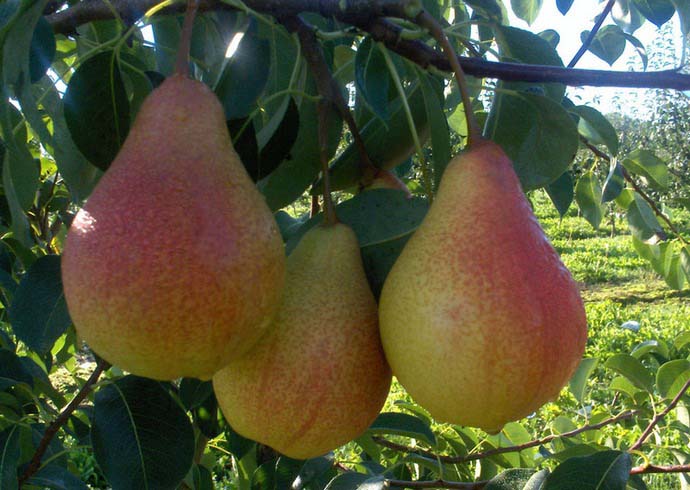
Summer oily
The plant is interesting:
- vigorous growth;
- wide pyramidal crown;
- large fruits of a yellowish color with a blurred blush;
- fine-grained oily pulp;
- scab resistant.
Fruit ripening occurs at the end of summer, but pears are stored for 10 days.
Lemon
The variety of folk selection is widespread among gardeners in central Russia, the Volga region, and southern regions. Small yellow pears are round in shape. Covered with dry skin. The pulp is greenish, dense. The tree is distinguished by its crown width and height up to 5-6 meters. Thin branches are covered with dark green oval leaves, wavy at the edges.
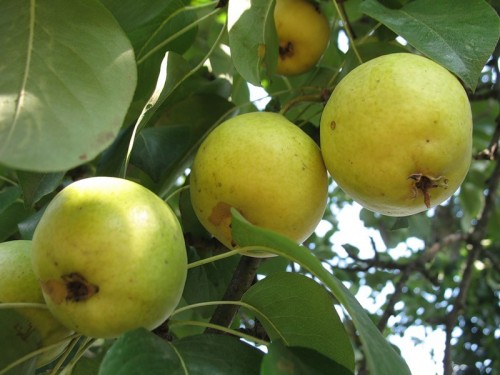
Rogneda
Late summer types of culture are represented by Rogneda. A pear was obtained by crossing the Forest Beauty with the Theme. Due to the inheritance of qualities from a wild relative, the hybrid can easily endure frosts. A medium-sized tree with a compact crown fell in love with summer residents. They prefer to plant it in the Moscow and Kaluga regions. The round pear is famous for its fruit taste. They:
- with a smooth thin skin;
- yellowish;
- weighing up to 140 grams;
- with numerous subcutaneous points;
- sweet, juicy.
The culture is prized for its resistance to low temperatures. Reaches consumer maturity in September and stays in a cool place for 2 months. It is better to pick unripe pears.

Sugar
The hybrid belongs to the cultures of southern selection. The fruits ripening at the end of July have an oblong-elongated shape. They stick well to the branches, rarely fall off. Spilled blush appears on the yellowish skin during sunny days. The pulp is such that it melts in the mouth. Along with the sweetness, there is a taste of nutmeg. The decorativeness of a low tree with a dense, well-leafy crown is noted.
Severyanka
The culture was bred in the middle of the last century, and it spread everywhere, from the southern regions to the Urals and Siberia. The tree is characterized by:
- fast growth rate;
- mixed fruiting;
- average crown dimensions;
- small fruits up to 80 grams in weight.
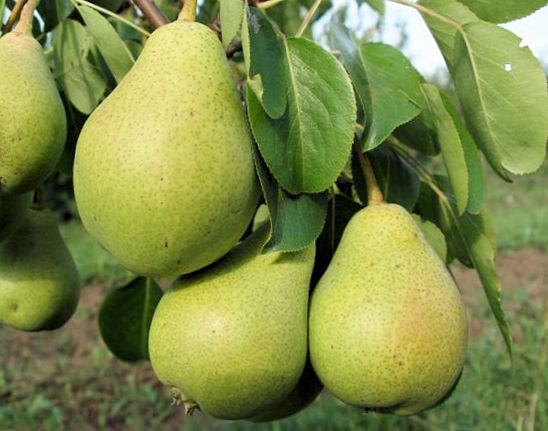
We fell in love with the pear for its juicy and crunchy pulp with a wine-sweet taste. Let the fruits not be stored for a long time, but they can be collected up to 20 kilograms from one tree.
Autumn
The advantage of pears ripening in autumn is their storage duration. Most of all the fruits need processing, so they must be tasty. It is the autumn varieties that are suitable for making jams, compotes.
Fresh, they can remain and not deteriorate for 1.5-2 months.
Bere Moskovskaya
The pear distribution area is Central. The culture is characterized by medium height, high growth rate of shoots. The fruit has a classic shape with slight asymmetry. Under the yellow skin with a scarlet blush hides white flesh, sweet and sour, juicy. Harvest in September, when the main color of the fruit becomes enlightened. Trees begin to give harvests in the 3-4th year of life. The plant is distinguished by winter hardiness, resistance to scab, brown spot.
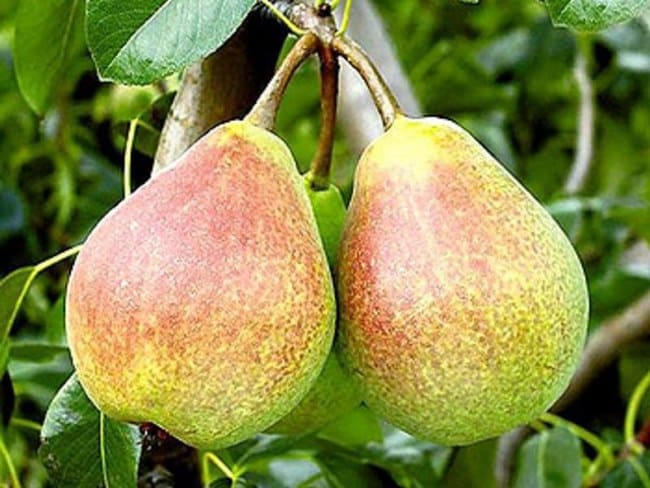
Bryansk beauty
The hybrid form is popular in the Black Earth regions. A medium-sized tree with a narrow pyramidal crown and a trunk on which a burgundy smooth bark. Young leaves are the same color, but as they mature, the plants turn green. Large fruits of 300-450 grams are noted in the variety. They are dark green at first, but then turn red blush.
They are famous for their oily pulp, very juicy, with a dessert taste and a pleasant aroma. The culture belongs to self-fertile.
Veles
The culture was obtained by crossing a wild pear with a varietal Venus. The plant is noted:
- average height;
- branching of the crown at a young age and compact pyramidality in the adult state;
- medium foliage;
- the presence of shoots, thick and long, curved.
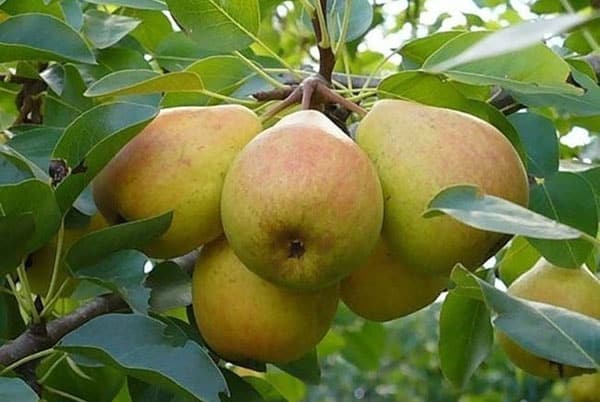
Fruiting in a ringed pear. Fruit weight from 150 grams to 200. From above they are covered with a smooth, not bumpy skin of a greenish-yellow color. The creamy pulp has a semi-oily texture. The fruits of the dessert variety are used fresh and for preparations.
Vermont
The advantages of growing the variety include the fact that the hybrid:
- adapted to drought and lower temperatures;
- gives good yields;
- famous for its delicious universal dessert fruits.
Suitable for growing in the Central Federal District.

Red-sided
For pears, the average height of the tree is characteristic, up to 4 meters in height. The crown is sparse, with crooked branches of brown color. They have large leaves of light green color. About the fruits of the variety, we can say that they reach a weight of 150-180 grams, are colored green. As they ripen, they become yellowish with a blush. The pulp is white with a sweet and sour taste. The purpose of the fruits is table.
Muscovite
The tree belongs to the standard types with gray bark, conical crown. The fruits are wide, pear-shaped. On the skin, a yellowish-green blush is spread. Sour-sweet fruits are fragrant, they just melt in your mouth.
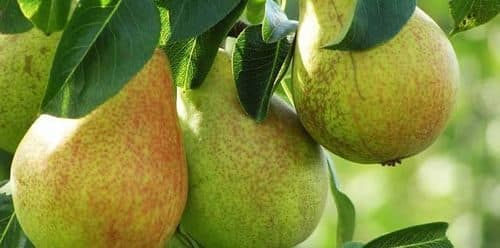
Marble
Pears ripen in early autumn and are suitable for planting in the Central and Volga-Vyatka region. The color of the fruits is interesting: on the yellowish background of the skin, there are red spots in the form of a marble pattern. Medium-sized pears have a sweet taste. The structure of the pulp is coarse. The hybrid is classified as a dessert species.
Otradnenskaya
Autumn pear was included in the State Register of Breeding Achievements in 2000. The standard tree has a spreading crown, gray branches perpendicular to the trunk. Young shoots are covered with brown bark. Small pears weighing 80-120 grams with a smooth matte skin, a slightly pronounced blush is spread on a yellowish surface. Taste qualities are estimated at 3.7-4 points.
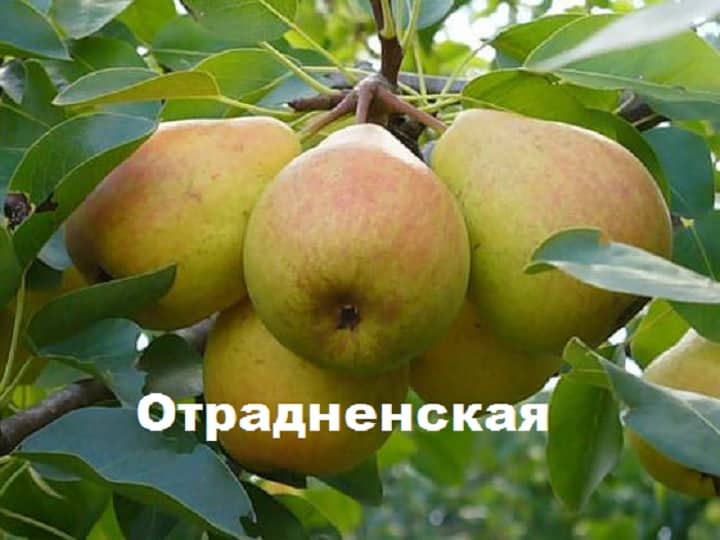
In memory of Yakovlev
One of the most common varieties in Russia is fast-growing. A short tree with a rounded crown is distinguished by a high awakening buds. The crops are harvested from it during September. They reach 25 kilograms per plant. With an average weight, pears with sweet pulp are used universally. They have no astringency, so they are eaten fresh with pleasure.
Ricks
The Riks hybrid is a frost-resistant and productive crop. It bestows fruits with a thin but dense skin, a slight blush on the side. The yellowish-pink flesh has a delicate and sweet taste.

Cheremshina
The culture was obtained back in 1960 at the Lvov experimental station. It is characterized by fast growth, narrow pyramidal crown. Bears fruit in the 5th year. The crop is harvested in October, but reaches consumer maturity in a month. Pears weighing from 150 to 250 grams with a pleasant sweetish taste. The skin above is greenish, rusty.
Winter
For long-term storage of fruits, winter-ripening pears are suitable. Under the right conditions, you can feast on them until spring. They are torn off hard, but during storage the taste of the pulp improves. Fruits are rarely suitable for making juices, compotes. Another advantage of trees is that they are hardy. Late flowering prevents frost from negatively affecting fruiting.

Angelis
The culture of French selection is famous for:
- large fruits of 300 grams;
- bronze coloring of the fruit surface;
- fragrant and juicy pulp;
- regular fruiting.
The plant is resistant to scab and fire blight. Grows best with annual crown lightening by pruning.
Decania
The analogue of Winter Duchess is very popular, because the pulp of the fruit is sweet, with a slight wine flavor, and melts in the mouth. The skin is firm, thick, but tender. Fruits grow on a medium-sized tree in the 5-6th year of life. As frost-resistant plants tolerate cold up to -30 degrees, they develop better on fertile, light soils with moderate moisture.
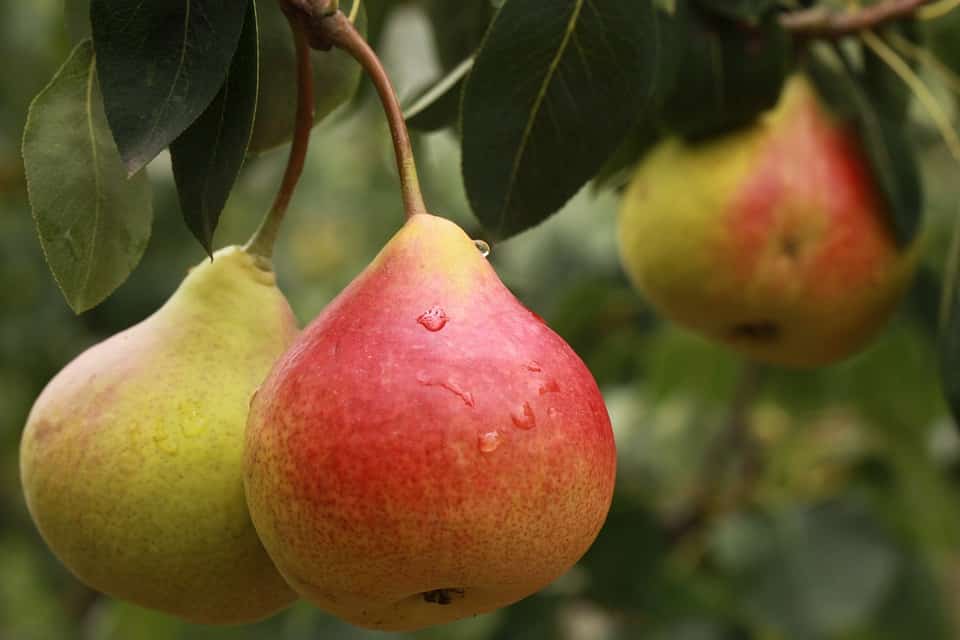
Golden
The winter type hybrid has a dessert purpose. Rounded fruits, covered with dry skin, greenish-yellow color, sweet and sour taste, with a spicy aroma.
Kondratyevka
Annually yields harvests of fruits that persist until January. In pears weighing up to 200 grams, the flesh is oily, sweet. Fruiting begins in a medium-sized tree 4-5 years after planting. It belongs to vigorous and well leafy.
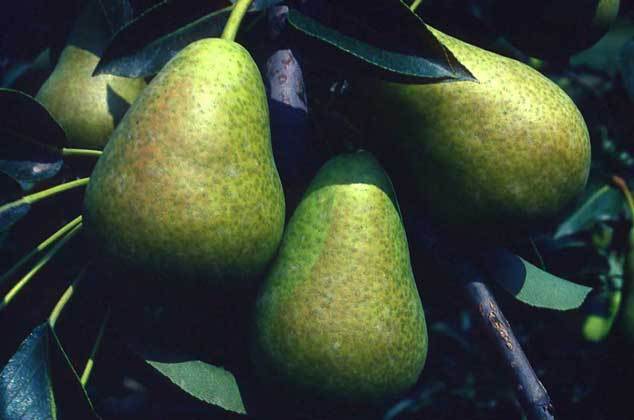
The conference
The tree is popular for its unpretentiousness. It bears ripe fruits at the end of September. They are large, elongated. The variety is characterized by brown skin, astringency, sweetness of the pulp. The disadvantage of a pear is its susceptibility to low temperatures.
Curé
The pear is zoned in the southern regions, where it has been growing since ancient times. In vigorous trees, the crown can reach 3.9 meters in diameter. Pear bears fruit on 3-year-old wood. Fruits reach a weight of 200-300 grams, there are specimens up to 500 grams. The hybrid is characterized by the color of the fruit is green, eventually changing to yellowish. A rusty strip in the middle, from calyx to peduncle, is characteristic.

Lyre
The pear obtained by crossing Bere Zimnyaya, Forest Beauty is famous for its large fruits, from 200 to 300 grams in weight. And their pulp is juicy, sweet with a slight sourness. Crops ripen on tall trees with a crown of medium density, pyramidal type. A large-fruited pear yields stably, tolerates low temperatures, and is immune to scab.
Malvina
Fruit trees are frost-resistant and yield yields of up to 100 kilograms under good growing conditions. Round-shaped yellow-green fruits reach a mass of 180 grams. After being removed from the branches, they are tart, but after maturation the taste improves. Fresh they are suitable for consumption until March.
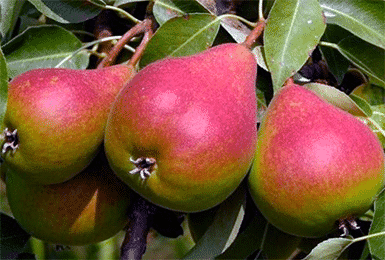
Maria
The variety was bred by Belarusian breeders and selected as winter-hardy, productive, with high-quality fruits. A tree of a medium-sized type with a pyramidal, wide crown at the age of 10 reaches a height of 3 meters. Pleases gardeners with juicy fruits weighing 300 grams or more. The yellowish surface is not rusty, but with dots of pink tan. The pulp is fine-grained, buttery with a delicate taste, slight acidity.
November
The early winter pear of Far Eastern selection grows into a strong tree with good branching, shoots extending directly from the trunk. Small fruits with irregularities are green with a large number of subcutaneous points. They have a pronounced aroma, sweet and sour taste.
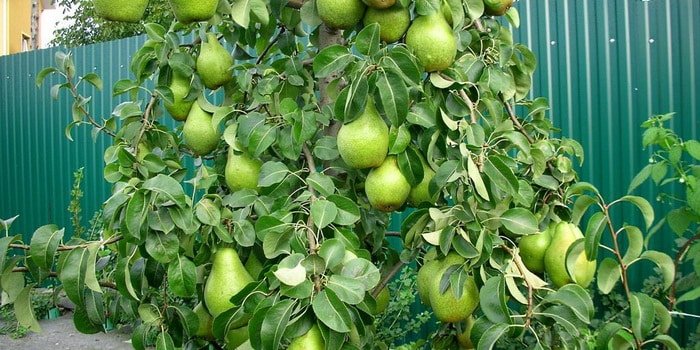
Patriotic
The culture is suitable for the southern regions, where it has been distributed for about 80 years. Fruiting in the 5th year after planting. The crop is harvested in October and stored in a cool place until March. Pear-shaped fruits are green at first, then turn yellow, and their taste improves.
Pass-Krasan
The popularity of the culture of French selection is that:
- The tree bears fruit in the 6th year of life.
- The yield is high under good growing conditions.
- Pears weighing up to 400 grams are removed, and up to 700 grams from those grafted on quince.
- The surface of the skin is golden-orange with rusty dots.
- The pulp tastes better than other varieties in sweetness, gentle astringency.

Pears are distinguished by good keeping quality, remaining until March.
Pervomaiskaya
On a large tree 6 meters high, the crown is narrow, a pyramid. He doesn't need pollinators. Classically shaped pears weigh from 150 grams with a length of 10 centimeters. The skin has an even yellowish color, and the flesh is soft but not watery. Harvests are removed up to 40 kilograms from a tree.
Saratov
In the variety, the tree reaches a height of 6-7 meters, with branches extending from the trunk at an acute angle upward. Elongated pears are covered with an oily, dull skin. Under it, the pulp is sweet and sour, without astringency. Starting from the 5th year of life, the crop ripens, but it is periodic. Trees rarely freeze, withstanding severe frosts. They are drought tolerant. Farmers can harvest pears up to 24 tons per hectare, they are well preserved and transportable.

Pears of central Russia
The special climatic conditions of the middle lane do not make it possible to bear fruit for all varieties of pears. In hot summers and harsh winters, not every plant can grow comfortably. And sudden changes in temperature can ruin unprepared specimens of garden culture. The region includes the regions of Nizhny Novgorod, Vladimir.
Weather conditions in such areas as Saratov and Yaroslavl are not favorable for some fruit crops.
Allegro
The hybrid is represented by a fast-growing tree with a slightly drooping crown. Elongated pear-shaped fruits reach a weight of 100-150 grams. Their surface is green with a slight pink tan. They ripen in the last decade of August. Delicate, sweet, without stony cells inside the pear are loved by gardeners.
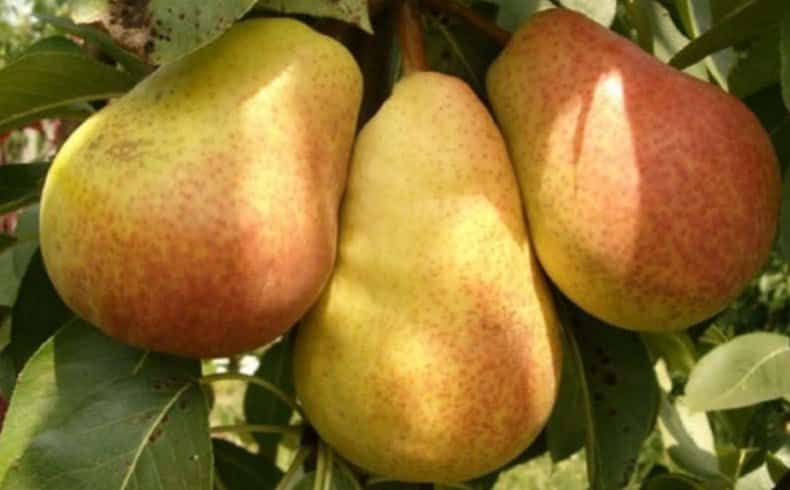
Bessemyanka
In the regions of Nizhny Novgorod and Yaroslavl, a hybrid is popular due to:
- fast growth rates;
- decorativeness of the crown with branches directed upwards;
- small fruits of green color with a slight blush;
- melon-yellow pulp of medium density and sweetness.
Pears are used to make compotes. You cannot store them for a long time, they quickly deteriorate.
Lada
In areas near the Saratov region, this early summer hybrid is widespread. It belongs to the standard types of horticultural crops. A variety of mixed fruiting type, sweet, with pears of 100 grams. They have a fine-grained, yellowish pulp, covered with a smooth and thin skin on top. Some specimens show a blush against a yellowish background.
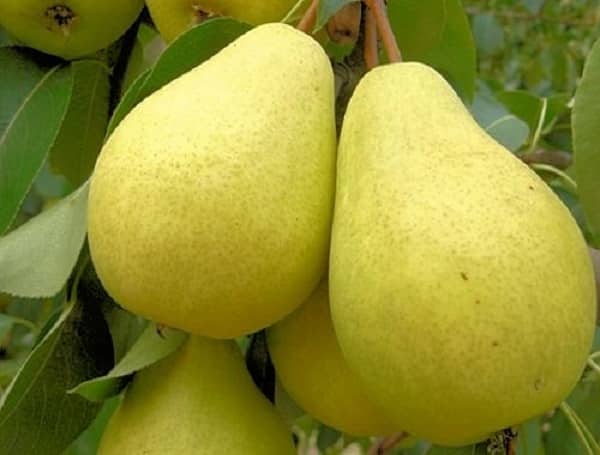
Skorospelka from Michurinsk
Zoned for the Central and Middle Volga regions, the variety is represented by a rapidly growing tree. It is necessary to place pollinators nearby, for example, a pear in Memory of Yakovlev. About the fruits, we can say that they are of the correct pear-shaped shape, weighing only 70 grams. Their cover color is green-yellow, in sunny weather - with pink spots.
Chizhovskaya
The late summer hybrid is named after the famous breeder S. Chizhov. The variety is popular in the areas of the middle lane because:
- has an average tree size;
- bears fruit in small pears;
- low shedding of fruits;
- good keeping quality of fruits.
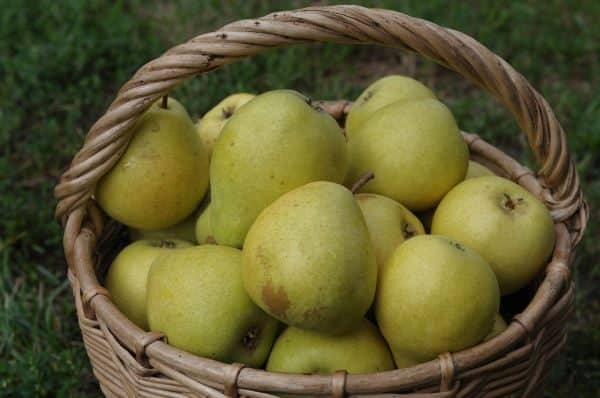
The pear is pleasant both in its shape and sweet refreshing taste.
Other types
Early varieties Vidnaya and Bryanskaya krasavitsa are suitable for growing in the region. From late summer, it is advised to choose a hybrid of the same age with high taste. Banana pear not only has a peculiar taste and aroma, but also big harvests. Veles pears, Thumbelina are also popular in this region.
Varieties for the Moscow region
In the Moscow region, although the summer is hot, but the winters are harsh. Therefore, sometimes there is not enough time for horticultural crops to mature. Suitable for planting plants with early and medium ripening.
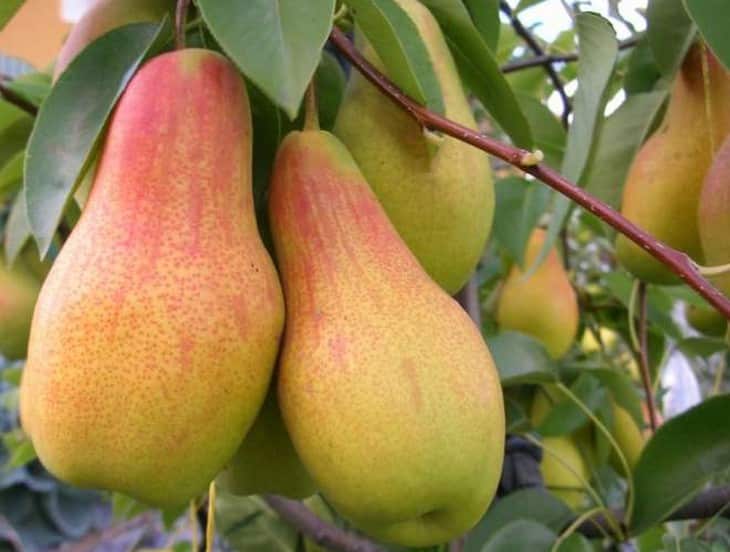
Venus
The pear is distinguished by its high winter hardiness. Entering fruiting in the 5-6th year of life, it brings rich harvests. Pears are removed in September. They weigh 120 grams, yellow-green, moderately juicy.
Vera Yellow
A winter-hardy culture that begins to bear fruit in the 6th year of life. It is appreciated for the fact that the fruit is sweet, tasty, juicy, with a smooth skin.
Prominent or Lumpy
Obtained by pollination with pollen from southern varieties and is suitable for industrial cultivation. On a vigorous tree, fruits appear in August. Their maturation is not simultaneous. An elongated dessert pear with a nutmeg flavor.
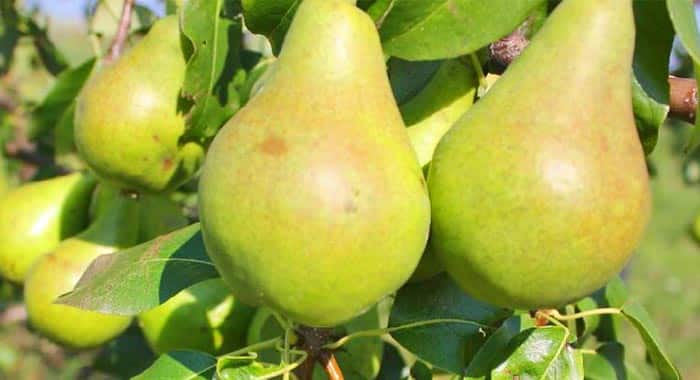
Elegant Efimova
The columnar hybrid produces crops during September. To prevent pears from overripe, they must be picked in time. The wondrous culture is famous for the high taste of fruits.
Tenderness
The tree is distinguished by beautiful large leaves, because of which fruits weighing 200 grams are visible. Their color is yellowish, there is a blush on the side. You can save pears for a long time.
Fabulous
The fruits of the variety are inherent in the fact that they:
- large, more than 250 grams;
- green with a yellowish tint;
- suitable for processing in mashed potatoes, jam;
- stored for 2 weeks.
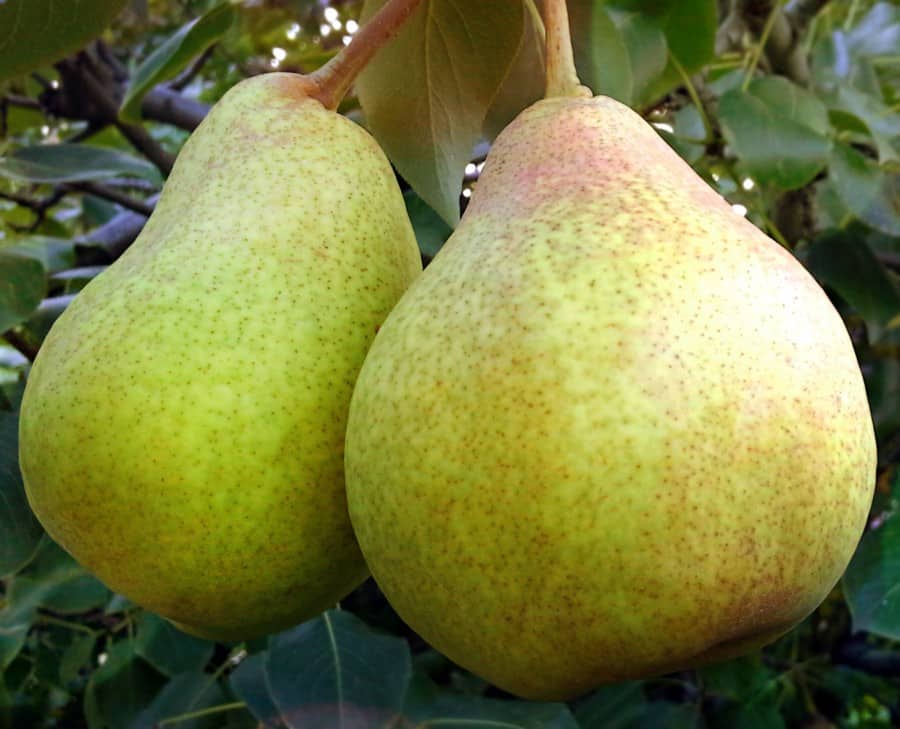
The hybrid is resistant to many fungal diseases.
Other varieties
In addition to the listed types of crops, in the Moscow region and nearby areas are grown:
- Conference;
- Muscovite;
- Yakovlev's favorite;
- Cathedral.
These pears have adapted to the weather conditions as they were bred by local breeders.
Varieties for the Southern Federal District
For the Rostov and Volgograd regions, it is easier to pick up seedlings of fruit crops. All types of summer, autumn and winter can be planted here. They will bear fruit abundantly. The only thing you need to look for is that the varieties are adapted to drought. The territory of the Krasnodar Territory is such a place that all garden crops feel comfortable and develop rapidly.
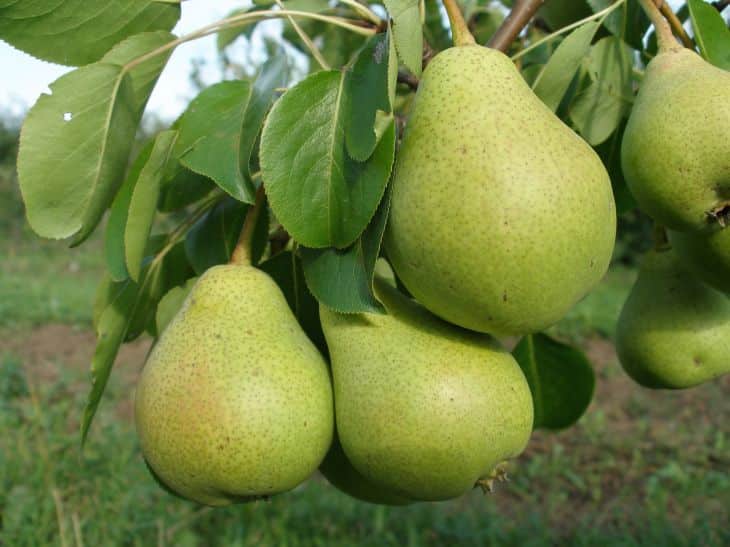
Disease Resistant Pear Varieties
To avoid fungal diseases affecting pear plantations, it is necessary to select varieties that are resistant to them.Such hybrids as Skorospelka from Michurinsk, variety Allegro are noted as the least sensitive to scab. The pear Gera, Yakovlevskaya has a high immunity.
Self-fertile pear varieties
In order not to bother with the planting of pollinators, it is necessary to select those crops that are pollinated on their own. When both female and male flowers are formed on the pear, the ovaries will form quickly. These types of plants include the Chizhovskaya pear, Tenderness, Maria.
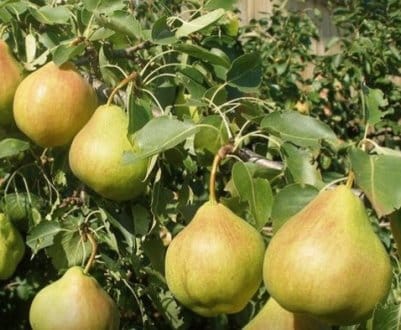
What kind of seedlings is better to choose
It is necessary to choose planting material so that the variety is suitable for the conditions of a particular region. In the south, annual seedlings are planted, in the northern regions - biennial. The best seedlings should have a healthy root system, smooth bark, and no damage. Their branches should not bend and be dry.
How to identify a pear variety
Before purchasing pear seedlings for growing, you need to pay attention to where the variety is bred. You can find out by a brief description of the culture. Such plant species are selected that are regionalized for a specific climatic zone. When buying, take into account the type of fruit ripening, their quality, and tree structure features.
